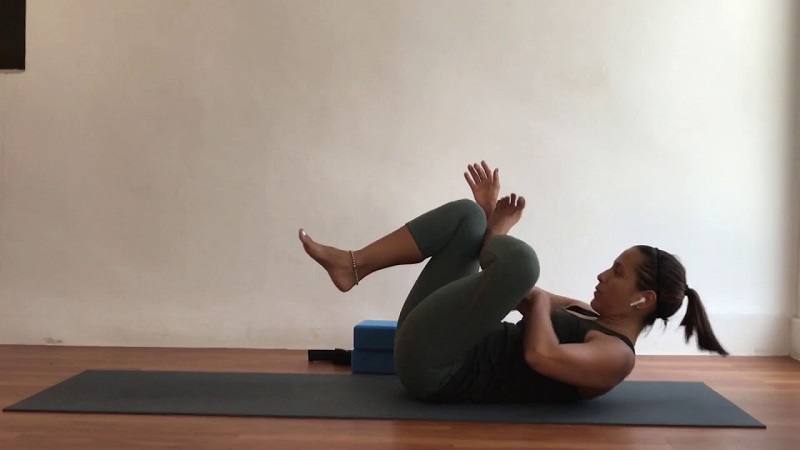Many asanas take their name from the objects, animals or figures evoked with the form of the posture. The examples are multiple: the raven, the tree, the lotus, the plow, etc. However, other positions honor legendary figures and heroes or great sages of Hindu mythology. To this last category belongs the position that we want to present to you this time.
We are talking about Kasyapasana, a posture dedicated to Rishi Kasyapa, an ancient Vedic sage, son of the sage Marichi. He is descended, in turn, from Brahma. Kasyapa was one of the Seven Sages (Saptarshi). It is considered the authors of various hymns and verses of the Rigveda, one of the four oldest texts in Indian literature known as Vedas.
Preparing the way of Kasyapasana
Performing this pose has a certain degree of complexity. The body needs certain levels of strength, flexibility, and openness to maintain it. Therefore, Kasyapasana is not a beginner’s pose. To be able to practice it, work with patience and perseverance on the following points:
Half Lotus. It is vitally important that you can achieve this position since, in Kasyapasana, you must maintain it with the hip joint in extension.
Flexibility. You can work the opening of the hips with poses such as Gomukhasana (cow face) and Baddha Konasana (butterfly pose). You will also need to have flexibility in your shoulders to take your foot, bypassing your arm behind your back.
Abdominal strength. A firm center is essential to be able to maintain this posture, even more than arm strength. The abdominal muscles are what maintain the alignment of the body. Navasana, the boat pose, is great for strengthening them.
Remember: Kasyapasana is a balancing pose and a fairly complex one. Don’t be frustrated if you can’t maintain it at first, even if you feel like you’ve already prepared your body properly. Many practitioners spend a long time before they can carry it out, even many advanced in the world of yoga.
It may also be that what is playing a trick on you is more of a mental aspect, of concentration. Keep your attention in the present. A good way to anchor yourself in the here and now is to pay more attention to your breathing. Focus fully on the pose, on your supports. Do not be afraid of falling and try to let go of the thoughts that may arise.
Kasyapasana Step by Step
The most common is to perform the posture by assembling the half-lotus on the ground and then raising the body to reach the final form as follows:
- Then, sit in Dandasana in the center of your mat.
- With the help of your hands, rest the instep of your left foot on your right thigh to form Half Lotus.
- Cross your left arm behind your back. At first, aim to grab your big toe with your thumb and index finger.
- Firmly rest your right hand on the floor, in line with your hips. Look for external rotation of the arm to achieve a greater opening in the back.
- Begin to shift your body weight to the hand on the ground while rotating your right foot and supporting its outer edge on the mat.
- Use abdominal strength and the push of your right hand to lift your hips off the ground until your entire body is aligned.
- Look for a greater opening in the back rotating from the left arm.
- Hold the pose for 5-10 breaths.
- Disarm the pose by lowering your hips slowly and in a controlled manner. Disarm the half lotus.
- You can disarm the foot position first, straightening the leg and placing it on the right.
- Repeat on the other side.
It is also possible to perform the pose from Adho Mukha Svanasana:
First, perform the downward-facing dog pose.
Begins to shift the body’s weight to the right side, slowly rotating. It is supported by the right hand and the outer edge of the foot. Your left leg will be extended on the right leg, without weight. Leave the left arm close to the body. Find balance in this pose.
Slowly bend your left leg, and when you’re ready, use your free hand to help you place your foot in the half-lotus position. Once you’ve accomplished this, cross your left arm behind your back and hold your foot.
Maintain and disarm the pose as indicated above.
Benefits of Kasyapasana
Strengthens abdominal muscles, arms, shoulders and back. Work the rotation of the hips and shoulders. Activates blood circulation to the digestive organs. Strengthens the support of the hands.
If you cannot master the half-lotus leg position, you can perform Vasisthasana, the side plank. Simply leave your upper leg straight, resting it on the one you are using for support. The free arm can rest on the body or you can extend it upwards, with the palm wide open. If you have problems taking your foot behind your back, you can take it in front of the body.

